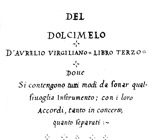
CHAPTER 3: History to 1800
3.5 The Baroque, Rococo and Classical Periods 1600-1800
3.5.1 The west
1.2. Higher cultures in the 17th & 18th centuries: Romance language-area
Documentary evidence: 1 of 14
[p.126]
There is in the Civic Museum at Bologna an unfinished MS from about 1600, by one Aurelio Virgiliano (later also written as Virgilio), which was clearly intended to be a three-part work comprising
 |
The last mentioned begins as follows:
"Libro terzo: Dove si contengono tutti modi da sonar qualsivoglia Instrumento: con, i loro Accordi, tanto in concerto, quanto separati.
Come si Accordi L'Organo; ii Gravecembalo; Il Salterio; L'Arpa; ii Lauto; La Tiorba e la Chitarra; La Cithara; La Lira; Insieme il Concerto delle viole; il concerto de Violini ...." (101).
'Third book: containing all ways of playing every kind of instrument: with the tuning, equally in consort as much as separately ...
'How to tune the organ; the harpsichord, the salterio; the harp; the lute; the theorbo and chitarra the cithara; the lira'.
 |
Unfortunately all Virgili(an)o left us of his work on the dulcimer was a rather beautiful title above a blank page to be filled in, for the only pages he finished were those of the viols and the cornett/sackbuts; but his work shows us that the salterio was certainly current, and that it was perhaps regarded sufficiently highly for it to be discussed before even the lute and the viols. This is, of course, not to say that the dulcimer was actually played more than viol or lute in Bologna of the 1600s, but presumably the author had some sort of structure in mind which placed the salterio at the beginning.
Then, of course, there's the title of the whole work, Il dolcimelo, which might well tempt us to think we'd found a book just about the dulcimer ... but we may sadly suppose that he was simply thinking of a 'sweet sound' in general ...
|
|